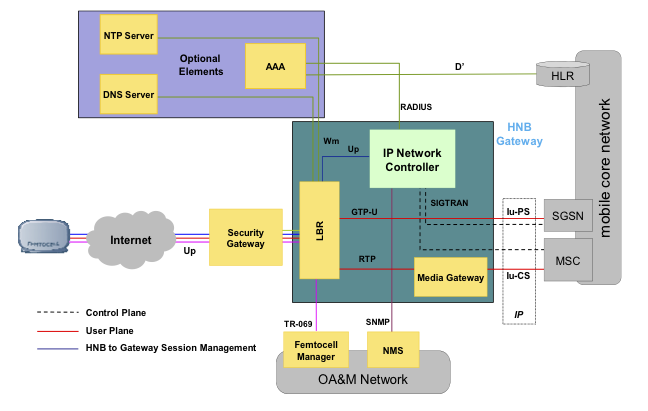How does a femto network work?
The advantages that the use of femtocells provides are already written on Habré, therefore, in this short article I would like to talk a little about the architecture of building femtocells on the operator side.
Femtocell (Eng. Femtocell) is a low-power and miniature cellular communication station designed to serve a small area (one office or apartment). It connects to the network of a cellular operator through a communication channel, connected to the user.
The picture below shows the general structure of femto networks.

Femto Access Point (FAP)- is a user device. FAP is installed on the user's territory and connects to the operator’s network through the user’s Internet channel and does not require user participation in initialization and configuration (zero touch plugand-play). The access point provides local 3G coverage and allocated capacity in the home or office and provides the user with the opportunity to use all the functionality of their 3G terminal.
Security Gateway (SeGW) - provides secure access to the operator’s network through the RAN GW, authentication and establishment of IPsec tunnels with the access point.
IP Network Controller (INC) - is a central component of the RAN GW solution, which provides a channel between the mobile operator’s network and the RAN GW.
Authentication, Authorization, Accounting (AAA) Server - Provides authentication between FAP and HLR using a standardized 3GPP security scheme.
Media Gateway Controller (MGW) - Manages CS streams and interacts with the MSC in the mobile operator’s network.
Load Balancing Router (LBR) is a CISCO router that is used to connect all gateway elements to each other.
Femtocell Manager - is a platform for managing HNB access points, the number of which can reach several million. Using the HNB Manager, you can manage the settings of the radio parameters, network interfaces, plan and perform software updates, set access lists in closed groups, and also manage the operation of access points in full.
Network Management System (NMS) - allows you to monitor accidents, manage the configuration and performance of RAN ‐ GW elements.
DNS server - provides recognition of IP addresses in a closed area of the operator’s network. For example, the HNB uses a DNS server to resolve the FQDN of the name of the serving INC node. The DNS server can be separate for each HNB GW or centralized for all HNB requests.
The NTP server is the synchronization source necessary to support the synchronization of all HNBs in the case when the HNB cannot be synchronized using the signals received via the 2G / 3G radio interface. The NTP server can be in each RAN GW or can be centralized for all RAN GW.
If some abbreviations from the note were not clear, I recommend readingarticle on the construction of UMTS cellular networks .
Femtocell (Eng. Femtocell) is a low-power and miniature cellular communication station designed to serve a small area (one office or apartment). It connects to the network of a cellular operator through a communication channel, connected to the user.
The picture below shows the general structure of femto networks.

Femto Access Point (FAP)- is a user device. FAP is installed on the user's territory and connects to the operator’s network through the user’s Internet channel and does not require user participation in initialization and configuration (zero touch plugand-play). The access point provides local 3G coverage and allocated capacity in the home or office and provides the user with the opportunity to use all the functionality of their 3G terminal.
Security Gateway (SeGW) - provides secure access to the operator’s network through the RAN GW, authentication and establishment of IPsec tunnels with the access point.
IP Network Controller (INC) - is a central component of the RAN GW solution, which provides a channel between the mobile operator’s network and the RAN GW.
Authentication, Authorization, Accounting (AAA) Server - Provides authentication between FAP and HLR using a standardized 3GPP security scheme.
Media Gateway Controller (MGW) - Manages CS streams and interacts with the MSC in the mobile operator’s network.
Load Balancing Router (LBR) is a CISCO router that is used to connect all gateway elements to each other.
Femtocell Manager - is a platform for managing HNB access points, the number of which can reach several million. Using the HNB Manager, you can manage the settings of the radio parameters, network interfaces, plan and perform software updates, set access lists in closed groups, and also manage the operation of access points in full.
Network Management System (NMS) - allows you to monitor accidents, manage the configuration and performance of RAN ‐ GW elements.
DNS server - provides recognition of IP addresses in a closed area of the operator’s network. For example, the HNB uses a DNS server to resolve the FQDN of the name of the serving INC node. The DNS server can be separate for each HNB GW or centralized for all HNB requests.
The NTP server is the synchronization source necessary to support the synchronization of all HNBs in the case when the HNB cannot be synchronized using the signals received via the 2G / 3G radio interface. The NTP server can be in each RAN GW or can be centralized for all RAN GW.
If some abbreviations from the note were not clear, I recommend readingarticle on the construction of UMTS cellular networks .
